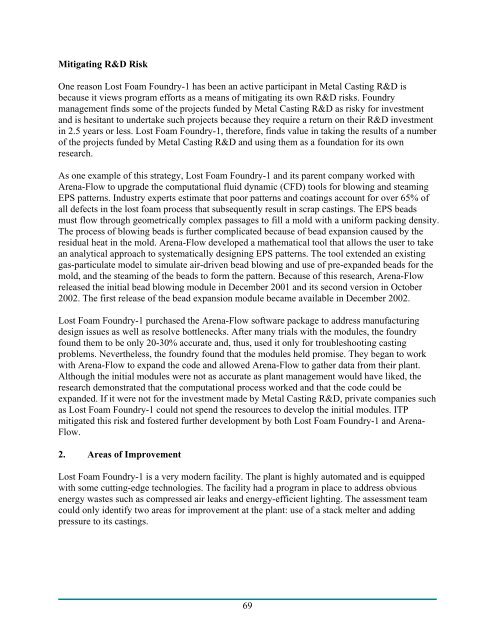Implementation of Metal Casting Best Practices - EERE - U.S. ...
Implementation of Metal Casting Best Practices - EERE - U.S. ...
Implementation of Metal Casting Best Practices - EERE - U.S. ...
You also want an ePaper? Increase the reach of your titles
YUMPU automatically turns print PDFs into web optimized ePapers that Google loves.
Mitigating R&D Risk<br />
One reason Lost Foam Foundry-1 has been an active participant in <strong>Metal</strong> <strong>Casting</strong> R&D is<br />
because it views program efforts as a means <strong>of</strong> mitigating its own R&D risks. Foundry<br />
management finds some <strong>of</strong> the projects funded by <strong>Metal</strong> <strong>Casting</strong> R&D as risky for investment<br />
and is hesitant to undertake such projects because they require a return on their R&D investment<br />
in 2.5 years or less. Lost Foam Foundry-1, therefore, finds value in taking the results <strong>of</strong> a number<br />
<strong>of</strong> the projects funded by <strong>Metal</strong> <strong>Casting</strong> R&D and using them as a foundation for its own<br />
research.<br />
As one example <strong>of</strong> this strategy, Lost Foam Foundry-1 and its parent company worked with<br />
Arena-Flow to upgrade the computational fluid dynamic (CFD) tools for blowing and steaming<br />
EPS patterns. Industry experts estimate that poor patterns and coatings account for over 65% <strong>of</strong><br />
all defects in the lost foam process that subsequently result in scrap castings. The EPS beads<br />
must flow through geometrically complex passages to fill a mold with a uniform packing density.<br />
The process <strong>of</strong> blowing beads is further complicated because <strong>of</strong> bead expansion caused by the<br />
residual heat in the mold. Arena-Flow developed a mathematical tool that allows the user to take<br />
an analytical approach to systematically designing EPS patterns. The tool extended an existing<br />
gas-particulate model to simulate air-driven bead blowing and use <strong>of</strong> pre-expanded beads for the<br />
mold, and the steaming <strong>of</strong> the beads to form the pattern. Because <strong>of</strong> this research, Arena-Flow<br />
released the initial bead blowing module in December 2001 and its second version in October<br />
2002. The first release <strong>of</strong> the bead expansion module became available in December 2002.<br />
Lost Foam Foundry-1 purchased the Arena-Flow s<strong>of</strong>tware package to address manufacturing<br />
design issues as well as resolve bottlenecks. After many trials with the modules, the foundry<br />
found them to be only 20-30% accurate and, thus, used it only for troubleshooting casting<br />
problems. Nevertheless, the foundry found that the modules held promise. They began to work<br />
with Arena-Flow to expand the code and allowed Arena-Flow to gather data from their plant.<br />
Although the initial modules were not as accurate as plant management would have liked, the<br />
research demonstrated that the computational process worked and that the code could be<br />
expanded. If it were not for the investment made by <strong>Metal</strong> <strong>Casting</strong> R&D, private companies such<br />
as Lost Foam Foundry-1 could not spend the resources to develop the initial modules. ITP<br />
mitigated this risk and fostered further development by both Lost Foam Foundry-1 and Arena-<br />
Flow.<br />
2. Areas <strong>of</strong> Improvement<br />
Lost Foam Foundry-1 is a very modern facility. The plant is highly automated and is equipped<br />
with some cutting-edge technologies. The facility had a program in place to address obvious<br />
energy wastes such as compressed air leaks and energy-efficient lighting. The assessment team<br />
could only identify two areas for improvement at the plant: use <strong>of</strong> a stack melter and adding<br />
pressure to its castings.<br />
69

















